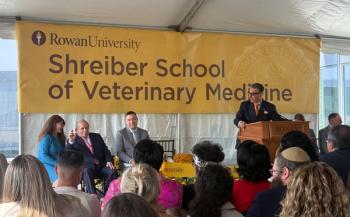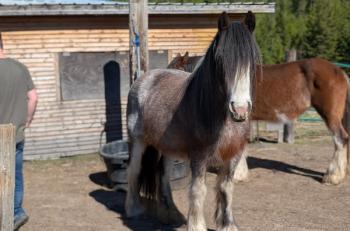
Managing oral trauma and foreign bodies (Proceedings)
The soft tissues of the oral cavity are susceptible to traumatic injuries by bits or other oral tack, sharp external objects, blows to the head, injury during recovery from general anesthesia, and iatrogenic damage during intraoral procedures-for example, administration of oral medications, dental extraction, or transoral epiglottic entrapment release.
Oral Cavity Soft Tissue Trauma
The soft tissues of the oral cavity are susceptible to traumatic injuries by bits or other oral tack, sharp external objects, blows to the head, injury during recovery from general anesthesia, and iatrogenic damage during intraoral procedures—for example, administration of oral medications, dental extraction, or transoral epiglottic entrapment release. The face and oral cavity soft tissues have a tremendous repairing capacity. Minor, superficial lacerations of the mucosa, lips, and tongue can heal effectively by second intention, usually within 2 weeks, without leaving a notable scar. Management may entail flushing of the oral cavity after meals with an antiseptic solution, warm salt water or clean water, and the use of nonsteroidal anti-inflammatory drugs. Larger wounds should be considered for surgical closure, to maintain tissue function, and for cosmesis. For these repairs, antimicrobial therapy may be needed in selected cases.
Tongue
Lacerations of the tongue are not uncommon and can be severe, with transverse lacerations more frequent than longitudinal ones. The free portion of the tongue is usually involved because of bit location and because this part has more exposure to the external environment. Clinical signs include oral hemorrhage, ptyalism, inappetence, anorexia, dysphagia, malodorous breath, pyrexia, and tongue protrusion from the mouth. Management of tongue lacerations is guided by the severity, duration, and location of the injury. Partial glossectomy, primary wound closure, or secondary wound healing are treatment options. Surgical procedures are most easily performed on the anesthetized patient; however, the tongue can be operated on in the standing horse with effective sedation and infiltration of local anesthetic. Traction on the tongue for exposure can be achieved by placing towel clamps in the tongue caudal to the laceration or by using a gauze snare at this site, which also serves as a tourniquet.
Partial glossectomy is reserved for cases in which the rostral tongue tissue is devitalized and minimal attachment is left between the severed section and the remaining body. Tissue color, temperature, and evidence of bleeding at an incision can be used to assess viability. After amputation, the remaining stump is meticulously débrided of nonviable tissue. Mucosal-to-mucosal closure of the stump is not imperative but is performed to aid hemostasis and hasten wound healing. Dorsal to ventral apposition is assisted by removing a wedge of intervening musculature and closing the created space with multiple rows of interrupted absorbable 2-0 or 0 sutures. The mucosal edges are subsequently closed with absorbable sutures of a similar size in an interrupted pattern, using tension relieving sutures as needed. Burying the knots in this layer will reduce the risk of suture tag irritation of the oral mucosa. Involuntary loss of saliva from the mouth may be observed after amputation of a large part of the free portion of the tongue.
Primary closure of severe tongue lacerations is encouraged whenever possible. The wound edges are débrided of necrotic and contaminated tissue and lavaged vigorously. A multilayer closure to eliminate dead space is recommended. To relieve tension on the closure, vertical mattress sutures are preplaced deep in the muscular body of the tongue with absorbable or nonabsorbable size 0 or 1 monofilament suture. Buried rows of simple interrupted 2-0 to 0 monofilament absorbable sutures are then used to appose the muscles, obliterating dead space. The vertical mattress sutures are tied, and the lingual mucosa is apposed with absorbable or nonabsorbable simple continuous 2-0 suture or interrupted vertical mattress sutures.
Second-intention wound healing for management of tongue lacerations is a viable option, particularly when economic constraints preclude surgical repair, and for chronic and less extensive lacerations. Oral lavage with a clean antiseptic solution two to three times a day and careful attention to the horse's ability to eat and drink are indicated. Lacerations that have healed by second intention but result in poor tongue functionality can be reconstructed using primary closure techniques after sharp débridement of scar tissue.
After lingual surgery, most horses eat normally, and temporary feeding via a nasogastric tube is rarely required. Gruels of pelleted feeds mixed with water, bran mashes, and wetted hay can be given before introducing drier feeds. Nonsteroidal anti-inflammatory drugs are administered, and antimicrobial therapy is used according to the level of presurgical tissue devitalization. Nonabsorbable sutures are removed in 2 weeks. Postoperative complications include excessive swelling of the tongue and suture dehiscence. The cosmetic appearance is usually highly acceptable.
Lips
Lip trauma occurs from protruding rigid objects in the horse's environment, such as metal buckets, nails, bolts, and hooks, or from iatrogenic bit damage. When there is major disruption, surgery is indicated to preserve lip function and cosmetic appearance. Injuries with extensive tissue contusion and devitalization should be managed by delayed primary closure to optimize the amount of healthy tissue for suturing; otherwise, most lacerations can be repaired at presentation. General anesthesia facilitates a meticulous repair, but standing surgery is possible with regional anesthesia techniques. The wound edges are prepared routinely by sharp débridement of damaged and devitalized tissues, and lavage. The lips are highly mobile tissues, and close adherence of the mucosa and skin to underlying musculature results in excessive motion at suture lines during prehension. This leads to a high incidence of dehiscence unless techniques are employed to stabilize the repair (Figures 1-3).
Figure 1: Laceration of lower left lip.
To reduce motion on the suture lines, the margins of the skin and oral mucosa are sharply undermined for 1 to 1.5 cm from the edges of the wound. Vertical mattress size 0 to 1 nonabsorbable sutures are then preplaced from the extraoral side through the lip musculature and tied over quills of soft rubber tubing, or through buttons. The mucous membrane is closed with simple continuous or interrupted 3-0 or 2-0 monofilament absorbable suture. The skin is apposed with simple interrupted or vertical mattress 2-0 to 0 nonabsorbable monofilament sutures. At the mucocutaneous junction, a vertical mattress pattern is used for precise apposition.
Figure 2: Laceration repaired with stents.
Chronic lip lacerations are reconstructed using similar principles as for the repair of acute injuries. A three-layer closure is employed, with the layers being created by sharp dissection of the skin and mucous membrane from the intervening lip muscle and granulating scar tissue. When repairing lacerations involving the commissure of the lips, additional vertical mattress tension-relieving sutures are placed rostral to the primary repair for increased support in this highly mobile area. Avulsions of the lower lip should be supported with large mattress sutures passed through the mandibular symphysis. Wire or nonabsorbable suture material is threaded through holes drilled from the outside of the lip and chin to exit caudal to the incisors in the oral cavity, and stents of soft tubing or buttons are placed under the sutures on the oral and external sides. Primary closure of the lip and gingival mucosa is performed if practical.
Figure 3: Repair has partially dehisced.
Nonsteroidal anti-inflammatory drugs are administered, and the oral cavity is lavaged with a dilute antiseptic solution or hose water two to three times a day if considered necessary. Antimicrobial administration is not required in most cases. A normal diet can be offered after surgery, and feeding by nasogastric tube or esophagotomy is unnecessary. The stent sutures can be removed after 7 to 10 days and skin sutures after 2 weeks. Mattress sutures used for repair of avulsion injuries are removed 2 to 3 weeks postoperatively. The most common postoperative complication is dehiscence of the repair. Horses have a tendency to rub the repair site, which may be limited by muzzling or cross-tying.
Cheek and Gums
Partial-thickness labial vestibule and buccal cavity lacerations are managed by second-intention wound healing with oral lavaging after meals and nonsteroidal anti-inflammatory drugs. Large, full thickness injuries may be reconstructed to prevent oro-cutaneous fistula development. Repairing the oral aspect of the wound is difficult because of limited space. Suturing the wound from the external side, starting with the mucosal layer, is more practical, using size 3-0 to 2-0 absorbable suture. Tension-relieving vertical mattress sutures should be used for the musculature using size 0 to #1 non-absorbable suture and the skin is closed with an interrupted pattern of size 2-0 to 0 non-absorbable monofilament.
Oral Cavity Foreign Bodies
Various types of metallic, usually linear, foreign bodies can penetrate the soft tissues of the oral cavity after inadvertent ingestion or iatrogenically during administration of oral medications. Plant matter, such as grass awns or wood splinters, is also a frequent cause of foreign body reaction. External clinical signs include focal or diffuse intermandibular, retropharyngeal, and facial swelling, depending on where the foreign body has lodged or what tissues it is migrating through. Swellings typically have increased heat, and the horse has evidence of pain to palpation of them. Often, antimicrobial therapy causes a reduction in the size of the swelling but it recurs when drugs are discontinued. A swollen, painful tongue, ptyalism, and partial to complete anorexia are the most common clinical signs of a tongue foreign body. Other clinical signs may include halitosis, dysphagia, tongue paralysis, and fever. There may be a painful response and difficulty when attempts are made to open the jaw. Oral and oropharyngeal examinations can reveal firm, painful swellings, the end of the foreign body, or ulcerated mucosal surfaces where the foreign body has penetrated the tissue, or where an abscessed site has ruptured spontaneously.
Diagnosis requires a combination of thorough history taking, external and oral examination, and imaging aids. Radiography is indispensable for detecting metallic foreign bodies, but care must be taken not to miss a fine, short structure. Open-mouth head radiographs can prevent tongue soft tissues from being superimposed over radioopaque dental elements that may conceal a subtle metallic body. Ultrasonography is very useful to help pinpoint the exact location of a foreign body and imaging via the intermandibular space and via oral direct contact with the tongue is recommended. Direct tongue ultrasonography may be performed in the standing, sedated horse, with a speculum in place, or when the horse is under general anesthesia. A 5-10 mHz rectal transducer provides excellent contact with the tongue surface. Ultrasonography is very useful for detecting the presence of lingual abscesses and the combined imaging from two approaches identifies the best surgical access to the foreign body.
Once a diagnosis is established, the treatment of choice is removal of the foreign body. In a few select cases, medical therapy alone may suffice if tongue function is normal and intralingual abscesses are minor or not present. In other cases the foreign body can be removed manually if it is palpated during examination. Surgical approaches may have to be creative. An external approach to a foreign body that has migrated into the deep part of the masseter muscle requires care to avoid trauma to facial nerve branches, the parotid duct, and blood vessels in that region. Foreign bodies associated with intraoral swelling may be approached by incising the mass on the oral side and draining exudate into the mouth. Digital or instrumental exploration and débridement of the cavity can then be performed. The cavity is lavaged and allowed to heal by second intention. Lingual foreign bodies can be very difficult to find and awkward to reach when they have implanted or migrated into the caudal body or base of the tongue. Surgery can be associated with significant hemorrhage if large lingual vessels are invaded. An ulcerative defect on the tongue surface provides a useful starting point for exploring a necrotic tract that is associated with the path of a foreign body. A ventral approach between the hemimandibles is necessary in some cases and allows triangulation techniques to narrow down the field of exploration when a second instrument is also passed via the oral cavity into the tongue body. When necessary, the caudal body or base of the tongue can be exposed more effectively after a mandibular symphysiotomy. An oral speculum, a bright light, and long-handled instruments are valuable aids. The mouth should not be extended fully open for prolonged periods of time in a speculum (more than 30 to 45 minutes), to prevent muscle and temporomandibular joint soreness postoperatively. Intraoperative ultrasonographic, fluoroscopic, and radiographic guidance may be required to locate the foreign body. Oral endoscopy can aid visualization.
Surgical and necrotic tracts in the tongue are left to heal by second intention. Postoperative care may consist of a combination of oral lavaging, necrotic tract lavaging, and antimicrobial and anti-inflammatory therapy. Ptyalism and tongue swelling can be a feature of the early recovery period. Soft feeds and gruels are fed after extensive tongue exploration, until the horse is more comfortable eating. The prognosis is excellent for complete recovery.
References
Hague BA, Honnas CM: Traumatic dental disease and soft tissue injuries of the oral cavity, Vet Clin North Am Equine Pract 1998; 14:333.
Ross MW, Gentile DG, Evans LE: Transoral axial division, under endoscopic guidance, for correction of epiglottic entrapment in horses, J Am Vet Med Assoc 1993;203:416.
Fuller MC, Abutarbush SM: Glossitis and tongue trauma subsequent to administration of an oral medication, using an udder infusion cannula, in a horse, Can Vet J 2007;48:845.
Barber S, Stashak TS: Management of wounds of the head, p273. In Stashak TS, Theoret CL (editors): Equine Wound Management, 2nd Ed, Wiley-Blackwell, Ames, Iowa, 2008.
Kiper ML, Wrigley R, Traub-Dargatz J, et al: Metallic foreign bodies in the mouth or pharynx of horses: seven cases (1983-1989), J Am Vet Med Assoc 1992;200:91.
Engelbert TA, Tate LP Jr: Penetrating lingual foreign bodies in three horses, Cornell Vet 1993;83:31.
Pusterla N, Latson KM, Wilson WD, et al: Metallic foreign bodies in the tongues of 16 horses, Vet Rec 2006;159:485.
Newsletter
From exam room tips to practice management insights, get trusted veterinary news delivered straight to your inbox—subscribe to dvm360.






